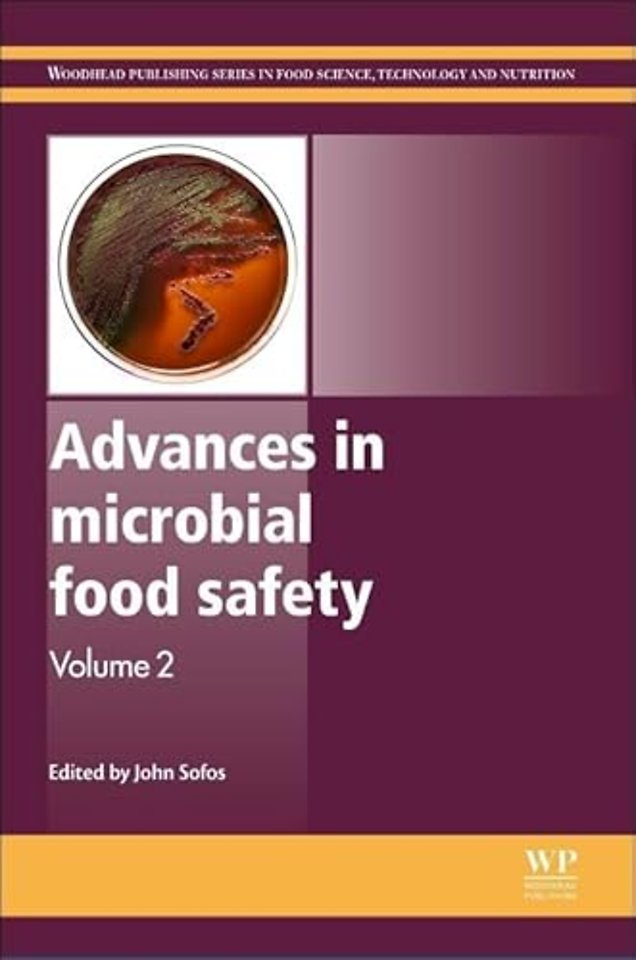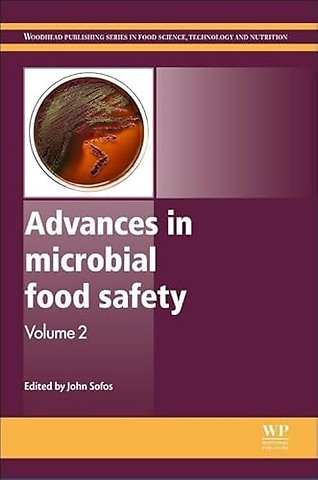<ul> <li>Contributor contact details</li> <li>Editorial advisors</li> <li>Woodhead Publishing Series in Food Science, Technology and Nutrition</li> <li>Part I: Hazards<ul><li>1: Update on non-O157 Shiga toxin-producing E. coli as a foodborne pathogen: analysis and control<ul><li>Abstract</li><li>1.1 Introduction</li><li>1.2 Virulence of non-O157 Shiga toxin-producing E. coli (STEC)</li><li>1.3 Animal reservoirs of non-O157 STEC</li><li>1.4 Outbreaks caused by non-O157 STEC</li><li>1.5 Transmission of non-O157 STEC to humans</li><li>1.6 Interventions for control of non-O157 STEC in produce</li><li>1.7 Interventions for control of STEC in cattle</li><li>1.8 Resistance of non-O157 STEC to stress</li><li>1.9 Detection of non-O157 STEC</li><li>1.10 Conclusions</li></ul></li><li>2: Update on Yersinia as a foodborne pathogen: analysis and control<ul><li>Abstract</li><li>2.1 Introduction</li><li>2.2 History and background</li><li>2.3 Evolution, genome, taxonomy and pathogenicity</li><li>2.4 Detection and identification methods</li><li>2.5 Epidemiology</li><li>2.6 Control</li><li>2.7 Future trends</li></ul></li><li>3: Update on Toxoplasma gondii as a parasite in food: analysis and control<ul><li>Abstract</li><li>3.1 Introduction</li><li>3.2 Morphology, structure and life cycle</li><li>3.3 Biology, genetics and genomics</li><li>3.4 Diagnosis</li><li>3.5 Epidemiology</li><li>3.6 Pathogenesis and clinical features</li><li>3.7 Treatment and prevention</li><li>3.8 Future trends</li></ul></li><li>4: The role of free-living protozoa in protecting foodborne pathogens<ul><li>Abstract</li><li>4.1 Introduction</li><li>4.2 Protozoa</li><li>4.3 Free-living protozoa in food-related environments</li><li>4.4 Free-living protozoa in drinking water and food</li><li>4.5 Interactions between bacteria and free-living protozoa</li><li>4.6 Significance of bacteria–protozoa interactions for food safety</li><li>4.7 Conclusions and future trends</li></ul></li><li>5: Update on foodborne viruses: types, concentration and sampling methods<ul><li>Abstract</li><li>5.1 Introduction</li><li>5.2 Challenges in detecting foodborne viruses</li><li>5.3 Types of virus</li><li>5.4 Methodologies for sampling and concentration</li><li>5.5 Conclusions</li></ul></li><li>6: Update on foodborne viruses: molecular-based detection methods<ul><li>Abstract</li><li>6.1 Introduction</li><li>6.2 Methods for detection of foodborne viruses</li><li>6.3 RNA extraction and purification</li><li>6.4 Molecular amplification and detection</li><li>6.5 Confirmation of RNA-amplified products</li><li>6.6 Real-time reverse-transcriptase polymerase chain reaction (RT-PCR) approaches</li><li>6.7 Nucleic acid sequence-based amplification (NASBA) assay</li><li>6.8 Reverse transcription loop-mediated isothermal amplification (RT-LAMP) assay</li><li>6.9 Biosensors</li><li>6.10 Microarrays</li><li>6.11 Next-generation sequencing approaches</li><li>6.12 Detection of infectious versus noninfectious viruses using molecular-based assays</li><li>6.13 Conclusions</li></ul></li><li>7: Update on Listeria monocytogenes: reducing cross-contamination in food retail operations<ul><li>Abstract</li><li>7.1 Introduction to the food safety issue</li><li>7.2 L. monocytogenes and listeriosis</li><li>7.3 Presence and prevalence of L. monocytogenes in retail operations</li><li>7.4 Transfer dynamics of L. monocytogenes at retail</li><li>7.5 The role of food workers in L. monocytogenes cross-contamination at retail</li><li>7.6 Risk assessment of L. monocytogenes in retail delicatessen</li><li>7.7 Mitigation options to control cross-contamination with L. monocytogenes at retail</li><li>7.8 Future trends</li></ul></li></ul></li> <li>Part II: Hazard management and control<ul><li>8: Developments in food disease surveillance: using source attribution to inform risk management<ul><li>Abstract</li><li>8.1 Introduction</li><li>8.2 Foodborne disease surveillance</li><li>8.3 Surveillance and the role of typing of foodborne pathogens</li><li>8.4 Producing evidence to inform policy to prevent and control foodborne diseases</li><li>8.5 Usefulness and applicability of source attribution methods for foodborne hazards</li><li>8.6 Future trends</li></ul></li><li>9: Modelling the spread of pathogen contamination in fresh produce<ul><li>Abstract</li><li>9.1 Introduction</li><li>9.2 Contamination of fresh produce: modelling pathogen growth behaviour</li><li>9.3 Case study: predicting pathogen growth on lettuce</li><li>9.4 Case study: modelling Listeria monocytogenes contamination of minced tuna</li><li>9.5 Summary</li></ul></li><li>10: Developments in validation and verification methods for hazard analysis and critical control points (HACCP) and other food safety systems<ul><li>Abstract</li><li>10.1 Introduction</li><li>10.2 Validating food safety systems</li><li>10.3 eassessment or revalidation of food safety controls</li><li>10.4 Validation of food controls: case studies</li><li>10.5 Verification of food safety management system activities</li><li>10.6 Validation and verification: a Global Food Safety Initiative (GFSI) perspective</li><li>10.7 Future trends</li><li>10.10 Appendix: Comparison of critical control points (CCPs) and prerequisite programs (PRPs)</li></ul></li></ul></li> <li>Part III: Particular foods<ul><li>11: Developments in sampling and test methods for pathogens in fresh meat<ul><li>Abstract</li><li>11.1 Introduction</li><li>11.2 Sampling plans</li><li>11.3 Testing for pathogens: hazard analysis critical control point (HACCP) systems</li><li>11.4 Principles and limitations of sample testing</li><li>11.5 Current US and EU methods of sample testing</li><li>11.6 Future trends</li></ul></li><li>12: Developments in Salmonella control in eggs<ul><li>Abstract</li><li>12.1 Introduction</li><li>12.2 Salmonella in laying flocks and eggs</li><li>12.3 Monitoring and controls in Europe before the EU baseline survey</li><li>12.4 The current situation in Europe</li><li>12.5 Human salmonellosis outbreaks in Europe</li><li>12.6 Incidence and control of egg-borne salmonellosis outside of Europe</li><li>12.7 Potential for eradication of Salmonella Enteritidis from laying farms</li><li>12.8 Potential treatments for eggs</li><li>12.9 Future trends</li></ul></li><li>13: The role of animal manure in the contamination of fresh food<ul><li>Abstract</li><li>13.1 Introduction</li><li>13.2 Animal manure</li><li>13.3 Foodborne pathogens associated with animal manure</li><li>13.4 Common practices in applying animal manure to agricultural fields</li><li>13.5 Persistence and transmission of human pathogens after land application of animal manure</li><li>13.6 Contamination of produce on farms originating from animal manure</li><li>13.7 Animal waste treatments to minimize contamination</li><li>13.8 Guidelines on direct application of raw animal manure or composted products to cropland</li><li>13.9 Conclusions</li></ul></li><li>14: Developments in improving the safety of sprouts<ul><li>Abstract</li><li>14.1 Introduction</li><li>14.2 Trends in the consumption of raw vegetables</li><li>14.3 Microbiological hazards in seeds and sprouts</li><li>14.4 Bacterial pathogens contaminating seeds and sprouts</li><li>14.5 Outbreaks of foodborne illness associated with the consumption of sprouts</li><li>14.6 Measures to control hazards associated with sprouts</li><li>14.7 Conclusions and future trends</li></ul></li><li>15: Food safety standards in the fresh produce supply chain: advantages and disadvantages<ul><li>Abstract</li><li>15.1 Introduction</li><li>15.2 Benefits and concerns relating to the implementation of food safety standards</li><li>15.3 Improving food safety management systems in the fresh produce supply chain</li><li>15.4 Future trends in food safety standards</li><li>15.5 Conclusions: the importance of training and risk communication for well-accepted and functional food safety standards</li><li>15.6 Sources of further information</li><li>15.7 Acknowledgements</li></ul></li></ul></li> <li>Index</li> </ul>

